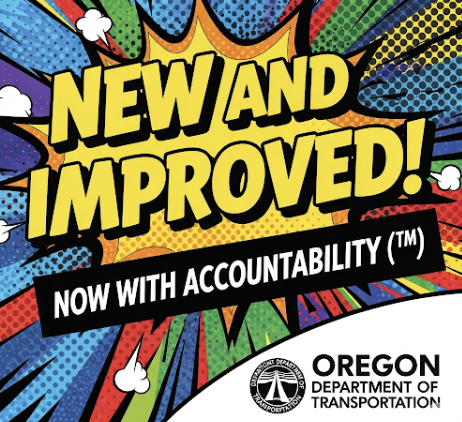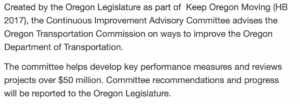New and Improved ODOT! Now with “accountability*”
Claims that Oregon DOT will be made more accountable are a sham
The trivial administrative changes that have been described as accountability, have already been tried, and simply failed to make any dent in ODOT cost overruns.
“Accountability” is just a phony talking point to sell tax and fee increases.
In an effort to convince everyone that there was really no problem with ODOT’s repeated multi-hundred million dollar cost overruns, the Legislature has been promising to include “accountability” as part of any proposed transportation tax and fee increase legislation.

The trouble is: all of the proposed “accountability” measures have already been tried, and simply failed to have any effect on the agency’s prolific cost overruns.
The Legislature hired consultants to come up with some accountability measures. It turns out that the AtkinsRéalis/Horrocks consultant report has a series of recommendations that are eerily similar to actions taken over the past decade to supposedly improve management at ODOT. Almost every one of the consultant’s key recommendations has already been recommended and at least partially implemented by ODOT–with no discernible effect on cost overruns.
AtkinsRéalis Recommendations vs. Previous Measures
| AtkinsRéalis-Horrocks Recommendations | Previously Implemented Oregon Measures |
|---|---|
| Create a “major projects office” to centralize management of large projects | 2019: ODOT created the “Office of Urban Mobility and Megaproject Delivery” |
| Create a “major projects dashboard” | 2022: ODOT launched “Transportation Project Tracker” (updated daily) |
| Establish joint executive/legislative/stakeholder “major projects committee” to oversee large projects | 2017: Legislature created “Task Force on Transportation Mega Projects” and “Continuous Improvement Advisory Committee” |
| Employ “RACI” management tool (responsibility, accountability, consultation, information) for decision-making processes | 2017: McKinsey recommended RACI to ODOT; agency already maintains RACI checklists for contracting |
Below, we’ve documented each of the Atkins-Realis recommendations, and shown how Oregon has already implemented identical or very similar measures over the past few years.
Renaming the Urban Mobility Office as the “Major Projects Group.” ARH’s very first recommendation re-christening the existing urban mobility office as a “Major Projects Group.”
It’s hard to tell how the changed name changes the responsibility or management of this team. Established in 2019, the office was originally named the “Office of Urban Mobility and Mega Project Delivery.” It was pitched as doing almost exactly what ARH recommended. Press accounts published sweeping claims that the office would address stakeholder feedback, and a implement a comprehensive approach that would deliver innovative solutions.
This new focus responds to public and stakeholder feedback and aligns with the visions of the Oregon Transportation Commission and ODOT Director Kris Strickler for the future of the transportation system.
ODOT’s newly formed Office of Urban Mobility and Mega Project Delivery is a key part of that comprehensive approach. While its work will continue to evolve, the office will immediately focus on developing and delivering innovative solutions for comprehensive congestion relief as directed by the Legislature in HB 2017.
Strickler laid out his vision for the new office.
“The creation of this office not only signals ODOT’s commitment to addressing congestion on all fronts but signals our new way of doing business.
There’s some minor shuffling of staff and decision-making authority, but the scope of the office’s responsibility remains the same: projects costing more than about $100 million.
A dashboard to track major projects. ARH recommends that ODOT establish a single, centralized dashboard for project information.
The ARH report, however, doesn’t mention that ODOT has such a webpage–the Project Tracker website–and has had since 2022, which contains this information. ODOT says the tracker “The interactive Transportation Project Tracker shows how and where Oregon’s state and federal transportation funds are spent by local, state and federal agencies. You’ll find information about the scope, schedule and budget of projects and studies . . .
Because ARH doesn’t acknowledge the existence of ODOT’s Tracker, it’s hard to know whether there’s any substantive difference between what they’re proposing and what ODOT already has.
Create an oversight committee. One of ARH’s long term recommendations is creating a broad oversight committee with representatives from the legislative and executive branches, local governments, and private sector representativs to monitor large projects.
This mirrors a similar oversight group—the Task Force on Mega Transportation Projects—created as part of the 2017 legislative transportation package.
SECTION 121. (1) The Task Force on Mega Transportation Projects is established. For the purposes of this section, a “mega transportation project” includes transportation projects, as defined in ORS 367.010, that cost at least $360 million to complete, that attract a high level of public attention or political interest because of substantial direct and indirect impacts on the community or environment or that require a high level of attention to manage the project successfully.
That Task Force on Mega Transportation Projects consisted of four legislators, and five other members including Oregon Transportation Commission members and road users appointed by the governor. It was tasked with monitoring projects of $350 million or more, and was legally required to file a report on its work–which it never did. It met just twice before in sunsetted in 2018.
HB 2017 also directed the Oregon Transportation Commission to create a “Continuous Improvement Advisory Committee.” Section 10 of the bill directs the committee to “advise the commission on ways to maximize the efficiency of the department to allow increased investment in the transportation system . . . develop key performance measures, based on desired outcomes . . . report to the commission at least once per year on the status of key performance measures . . and in each odd-numbered year, the commission shall submit a report . . . to the [Legislature’s] Joint Committee on Transportation.” The committee focuses on projects costing $50 million or more and meets about nine times per year. ODOT’s website describes it as follows:
Management Buzzwords. A popular management buzzword is “RACI” for “responsible, accountable, consulted and informed.” The AHR report calls for ODOT to adopt a RACI framework to guide its relations with partners and contractors.

But that should sound familiar. McKinsey made almost exactly the same recommendation in its 2016 report on improving ODOT’s management.

And, in fact, ODOT does use “RACI” to spell out how it manages different construction contracting arrangements, including “Design-Build” and “Construction General Manger Contractor.” Here’s the RACI framework from ODOT’s website:
In short, there’s nothing new that’s been proposed to increase “accountability” by ODOT, and what has been proposed would really do nothing to affect the cost or delivery of ODOT projects. Accountability exists only as a charade to fool the media, the public, and probably legislators, that something is being done to fix an agency that routinely has cost overruns of 100 percent or more on major projects, and isn’t getting any better.




